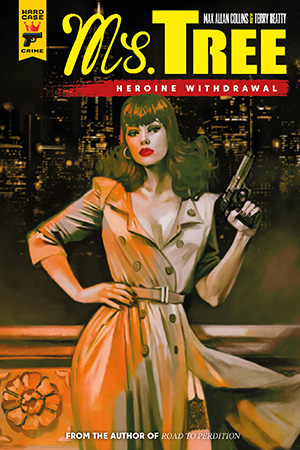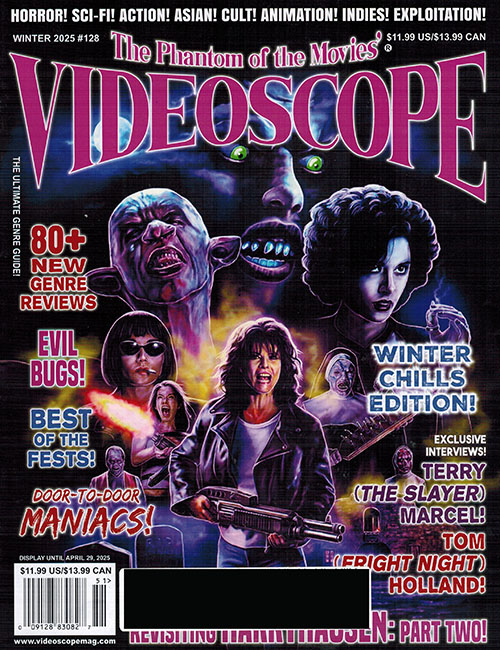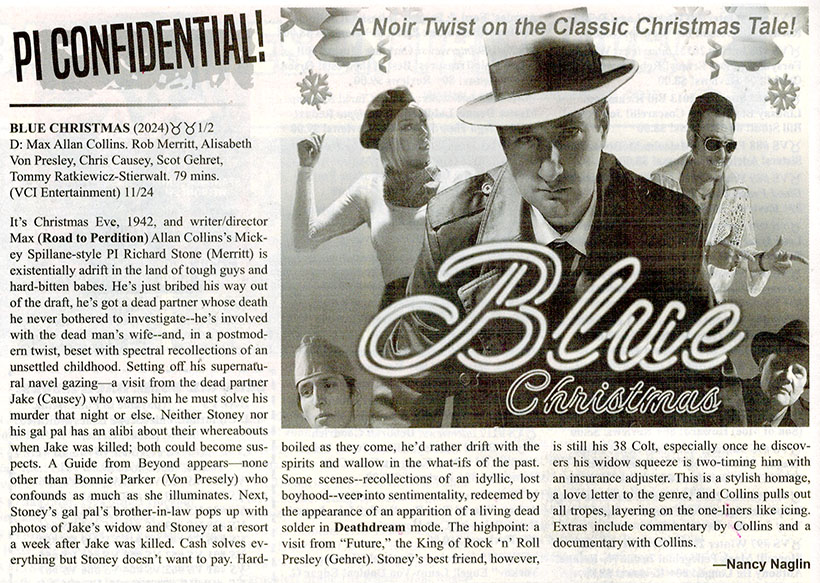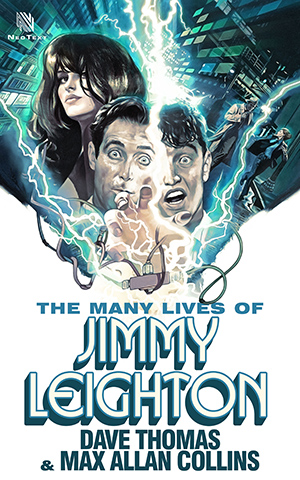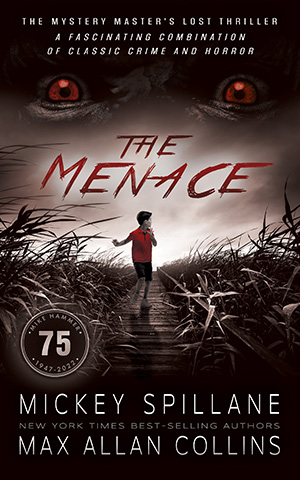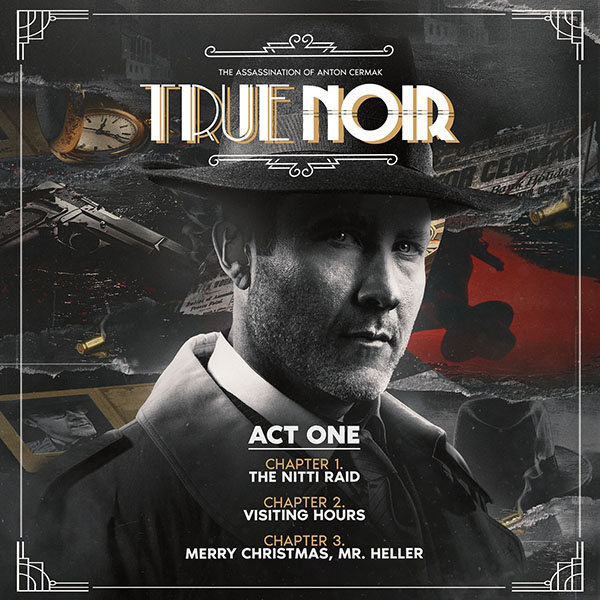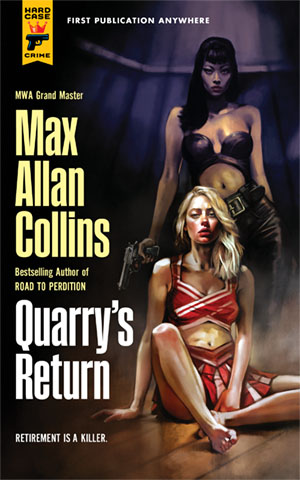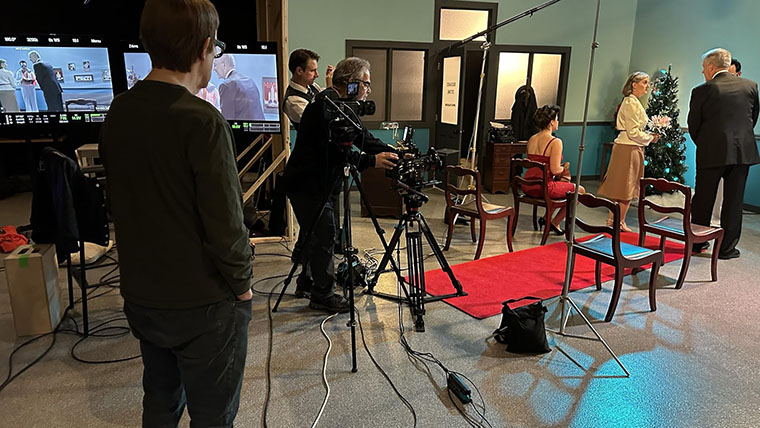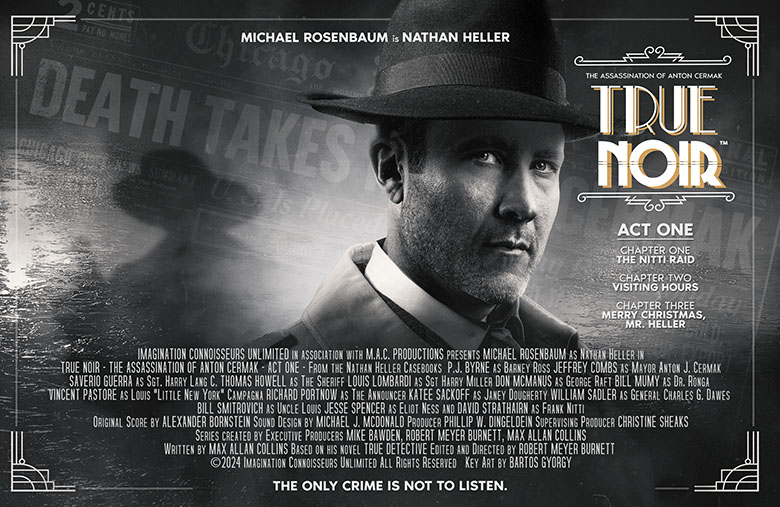At the Reading Is Fun, Not Mental website, “TL” wrote this terrific Ms. Tree – Heroine Withdrawal review, the fifth of the six Ms. Tree collections from Titan.
I can never get enough of Ms. Tree. Ever since I picked up that first issue of Ms. Tree’s Thrilling Detective Adventures (which I still love that title, even though I’m aware Ms. Tree’s creators do not – for me, it gave the book a pulp feel, which I think fit the character nicely), I’ve been hooked, and I was devastated when the series eventually ended after years at Eclipse, then Aardvark-Vanheim, then Renegade Press, and finally DC Comics. So, when Titan announced it would be collecting and reprinting the entire run, I was super-excited – sure, I had all the individual issues; but now I would have easy access to reading the stories again and again and again without having to dig through my comic boxes, unseal the bags, and pull out issue after issue to read them. Even though the collections are not telling the stories in order (they reprinted the ten DC issues first, then went back to the beginning to start with the Eclipse issues, before moving on to the AV and Renegade issues – and even those have been told somewhat out of order, collecting them by story relevance and not chronologically), I have absolutely loved curling up in my recliner and walking down memory lane with Ms. Tree, Dan, Effie, and the rest of the gang…
Ms. Tree: Heroine Withdrawal collects issues 18-27 and 29-31 (with the title having officially switched fully to Renegade Press by issue 19). These are some of my favorite issues, as they deal with Ms. Tree’s final confrontation with Dominic Muerta and the aftermath – as well as a two-part story that dealt with the topical issue of abortion. This is some of Max Allan Collins’ best writing in the series, as they give the readers a real sense of why Ms. Tree is who she is and why the world (well, her fictional world, anyway) needs a Ms. Tree in it. It’s also extremely character driving, as most of the series is anyway – but these issues in particular give readers a greater understanding of not just Ms. Tree, but also many of the supporting characters. Plus, we get our introduction to Dominique Muerta (gotta love Collins’ play on names in this series), who turns out to be a wonderful frenemy for our favorite gun-toting crime-fighter!
“Muerta Means Death,” the four-issue story that runs through issues 18, 19, 20, and 21, provides readers with a very satisfying conclusion to Ms. Tree’s vendetta against the man who had her husband killed. The title has a double meaning, since the word “muerta” is actually the Spanish word for “dead,” and at the same time, it refers to the fact that Dominic Muerta is a killer, and if you cross him, you die. I suppose it could also have a third meaning, since in the story, we learn Muerta has cancer and is on his death bed – and when Dan Green comes back to work (with a hook in place of the hand he lost in the explosion set by Muerta’s men in a previous story), he’s all set to take revenge on Muerta. It all gets confusing when Dan goes to Muerta’s house prepared to kill him – and when Ms. Tree and the police get there, they find Dan just waking up in the same room where Muerta and his nurse are both dead! Dan swears he did not do it, and Ms. Tree sets about proving his innocence. The story takes a few surprising twists, with the final one giving Ms. Tree the satisfaction she has been seeking – definitely a great read, and for astute readers (who have become accustomed to Collins’ playing with names), Muerta’s attorney, Dimitri A. Dopler, should give you a huge clue as to one of the biggest secrets in this story!
Following this big payoff, Collins gives readers a few shorter stories – the first being “Right to Die,” which addresses the issue of abortion and readers find out that Ms. Tree had an abortion when she was younger, an act she regrets now that Mike Tree is dead, and the only child she could have had with him is gone. The story addresses the issue without straying into preaching which side of the issue is “right” – instead, the story focuses on how various people deal with abortion and the doctors who perform the procedures. It has a sad ending, and let’s just say there are no real winners in this one – especially for Ms. Tree, as her actions in this story have serious repercussions…
Leading into the next two-parter, “Prisoner Cell Block Hell,” in which Ms. Tree does time in a women’s prison (with all the standard stereotypes you’d expect to see), and Ms. Tree has to face someone coming after her – after all, as the saying goes, the past always has a way of catching back up to you. After unveiling some very corrupt prison guards, Ms. Tree then gets transferred to a psychiatric facility in the two-part “Heroine Withdrawal.” For those who remember the very first Ms. Tree story in her own comic (after her origin in Eclipse Magazine), Ms. Tree has a reason to be wary of psychiatrists – and for good reason!. Only this time around, she manages to reveal the unscrupulous actions of a nurse and orderly, as well as a high-powered politician! And she makes a new friend who may or may not have been taken by aliens (let’s just say Collins leaves it up to the reader to decide at the end of the story…)
This collection concludes with the three-issue tale, “The Other Cheek,” which introduces us to a newly reformed Ms. Tree who has completed her psychiatric care and has decided to walk away from all of the violence, not even carrying a gun any more. This, of course, forces all of those who work with her – including Effie! – to step up their game, because when it comes to Ms. Tree, danger is never far away. It’s not until her stepson, Mike (named after his father), is kidnapped that Ms. Tree realizes she has no choice, and she throws off the new persona and steps back into the shoes she was made to fill – that of a female vigilante who fights for justice, and always wins! One thing I thought was a great choice for Beatty in this story (and I don’t know if it was his idea, or if Collins told him to do it), but I loved the fact that “reformed” Ms. Tree dressed so much differently – even wearing flower-print dresses! But when she goes back to her old self to rescue Mike, she once again dons that blue overcoat that give her such distinctive style! It makes for a nice visual aid to her change in character back and forth.
With only one more collection go to complete the reproduction of the entire run of Ms. Tree, I hope the sales on these collections have been such that Collins and Beatty will consider telling some more stories. With all of the controversies in the news today, they would literally have a plethora of topics to pick from to create some great tales! And who knows? Maybe they could even age the characters, so that Mike (her stepson) could be old enough to work along side her – what a story that would be! Any way you say it, we definitely need MORE MS. TREE!!!!!!
Rating: 10 old-fashioned dynamite bombs out of 10 for some truly dynamite story-telling, masterful twists and surprises, and some of the best artwork you will ever see in a comic! What more could you want?
When I read a review like this, two things come to mind: how wonderful! And, “Where were people like you when we were doing this title in the ‘80s and ‘90s”?
Terry Beatty and I began Ms. Tree as what we thought of as an exercise in coherence. Comic-book art was getting very complex and even impenetrable, and I wanted to return to the EC-style Johnny Craig school (derived from classic comic strips, chiefly by Milton Caniff) and Terry was wholeheartedly on board.
We’d been invited by Dean Mullaney to be part of his Eclipse magazine, which had a lot of top comics creators contributing new potential series. Also included in the mix were Terry and me. While Terry and I had done several projects together, we were only in this heady company because Dean was a Dick Tracy fan and I’d attracted some nice attention in the field when I took over the writing of that strip from creator Chester Gould in December 1977.
My basic concept was “Velda and Mike Hammer finally get married, and Hammer gets murdered on their wedding night and Velda takes over the PI agency…and seeks revenge.” I believe I pitched it off the top of my head when the surprise phone-call invitation came from Dean.
Another surprising thing happened after that: we were the dark-horse hit of the magazine and got spun off into our own comic book. Thanks to Dean, and later Dave Sim, Deni Loubert and Mike Gold, we continued through four publishers, ultimately DC. We had several movie options, and I did a little indie film, Real Time: Siege at Lucas Street Market, based on a Ms. Tree prose story of mine, although we were in the midst of a movie option at the time and I had to change Ms. Tree’s name. But the character Brinke Stevens played was as close, to date, of Ms. Tree coming to life on screen. Brinke did a great job on our $10,000 (!) movie, which got national distribution (okay, Troma, but that counts).
The glowing review I share here does not reflect the critical response to Ms. Tree back in the day. A lot of folks, including some who liked our comic book series, thought we were crazy doing a crime/mystery comic book in a super-hero world. We probably were, but between me writing Dick Tracy (at the time) and my mystery novels, it made sense to us.
We did get our share of nice notices – we wouldn’t have survived so long if we hadn’t – but we were singled out for withering criticism from some, particularly the Fantagraphics crowd. That got nasty and rather acid on both sides, because Terry and I were both stupid enough to take Gary Groth and company on. It was a no-win situation, and a study of what a suicide note it is to respond to criticism. (Doing so is something I try desperately to avoid, but I still occasionally, misguidedly do. I should not. I hope at this age and stage I have finally learned that lesson.)
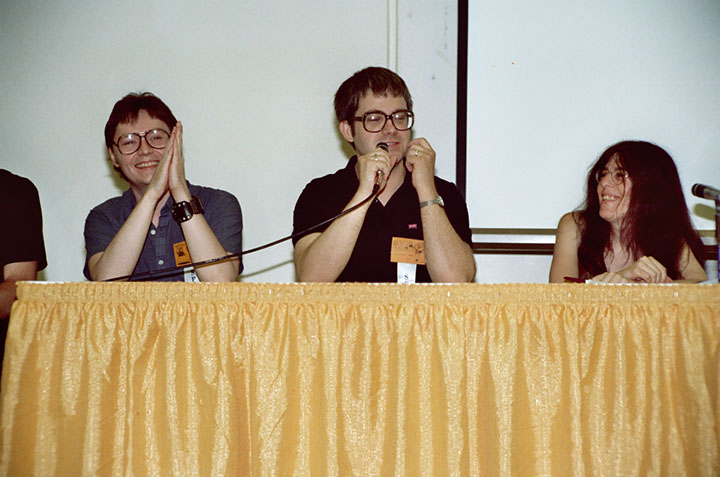
Terry Beatty and Max Allan Collins at San Diego Comic Con 1982 (with Cat Yronwode; photo by Alan Light)
Terry and I were a team for a long time. We did Wild Dog as a mini-series followed by a serialized run in Action Comics and one fat little one-shot. We put together a Johnny Dynamite mini-series (collected as a graphic novel) for Dark Horse. And finally I brought Terry into the Road to Perdition fold with the DC graphic novel, Return to Perdition.
During our team-up time, Terry and I had many failed projects, most of them having to do with pitching comic strips to my then-bosses at the Chicago Tribune Syndicate. Our “Comics Page” that we self-syndicated to weekly shoppers was a good idea whose time never came (it ran a struggling year or so).
We also pitched a retro version of Batman to DC that was rejected but (somewhat ironically) was close to what would soon be done on Batman: The Animated Series. I say somewhat ironically because Terry went on be one of the Eisner Award-winning artists on the comic book series inspired by that show. I also worked on Batman, too, mostly a disastrous year-long experience on the monthly comic, although my work on the syndicated comic strip (I was forced off by the Chicago Tribune Syndicate after the first story) and the graphic novel Batman: Child of Dreams (from Kia Asimiya’s manga) were better received by readers and, well, me.
Still, that Terry and I were both on Batman but never together is another unfortunate irony. We did get do Wild Dog for DC, which generated a character featured on the Arrow TV show (which I never bothered to watch) (and had to complain to get paid).
Another irony is that Terry and I both wound up doing something apart that we’d long tried to do together. When Dick Tracy artist Rick Fletcher passed away, I tried to get the Tribune syndicate to use Terry as my artist. They turned him down, despite samples that pleased me very much. And we suggested, and submitted samples (initially well-received), for a reboot of the Little Orphan Annie comic strip, taking advantage of the Broadway show’s success. We were ultimately turned down, but the great Leonard Starr was enlisted to do the re-boot we’d suggested.
So when “TL” above suggests Terry and I should do more Ms. Tree, the irony (there’s that word again) is that Terry is now too busy as he’s a successful writer/artist in the syndicated comic strip field. After a run on The Phantom Sunday page, Terry moved over to handling the Rex Morgan, MD, comic strip, where he has done and is doing a fine job.
Prior to that we’d kicked around reviving Ms. Tree. It was what held up the Titan archival reprint series of the original comics – we wanted to launch that reprint series with a new graphic novel. But that never came together, although I did some preliminary work.
The silver lining here is that Titan – thank you Nick Landau and Vivian Cheung – has collected the more-or-less complete Ms. Tree in six beautifully produced volumes, in all their color and two-color glory (a long run of Ms. Tree employed one color in various shades, to create a noir feel…and save money). I say “more or less” because a few odds-and-ends haven’t been gathered in these books, and those leftovers weren’t sufficient for another volume to be produced.
I haven’t talked about it here, at least not very much, but getting the complete run gathered in archival volumes, with Terry very much supervising, has been a goal I’ve long hoped Ms. Tree could reach. Terry and I put a great deal of hard work and love for the genre into Ms. Tree, for over a decade, and now it exists in more enduring format.
I will add that someone recently wrote in to my pal Robert Meyer Burnett on his fine YouTube show, Robservations, that someone should do a graphic-novel version of our Nathan Heller audio series, True Noir (based on Heller’s debut, True Detective. The talent suggested for the job (not by Rob!) were current crime-comics favorites, like Ed Brubaker. Nothing against Ed, but I think I could put any interested publisher in touch the (wait for it) writer of a fairly well-regarded graphic novel, Road to Perdition.
M.A.C.
